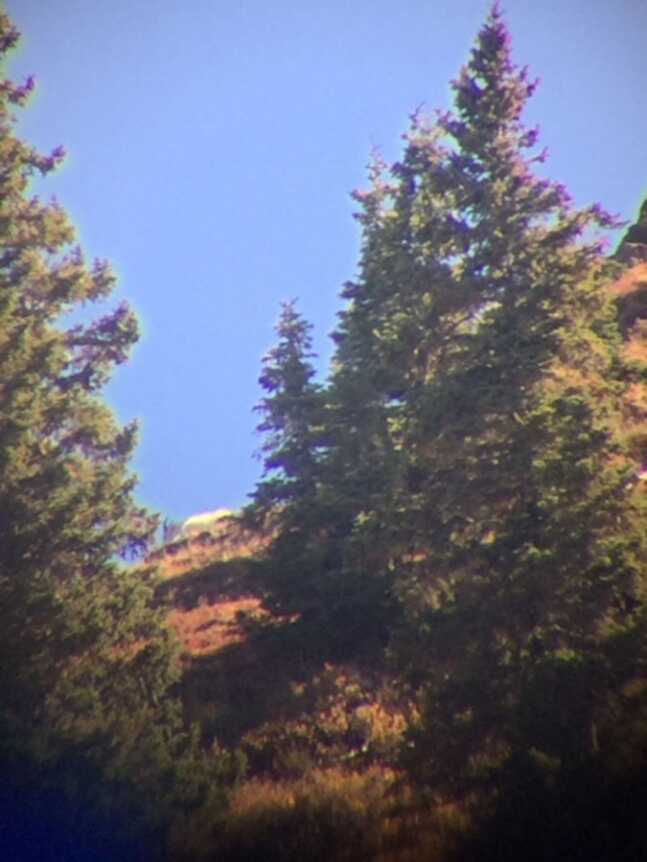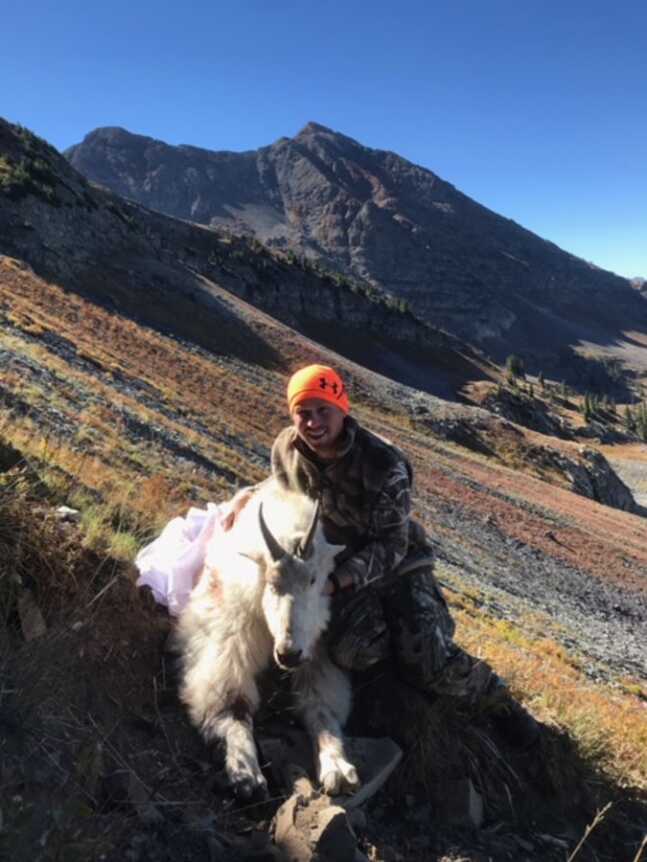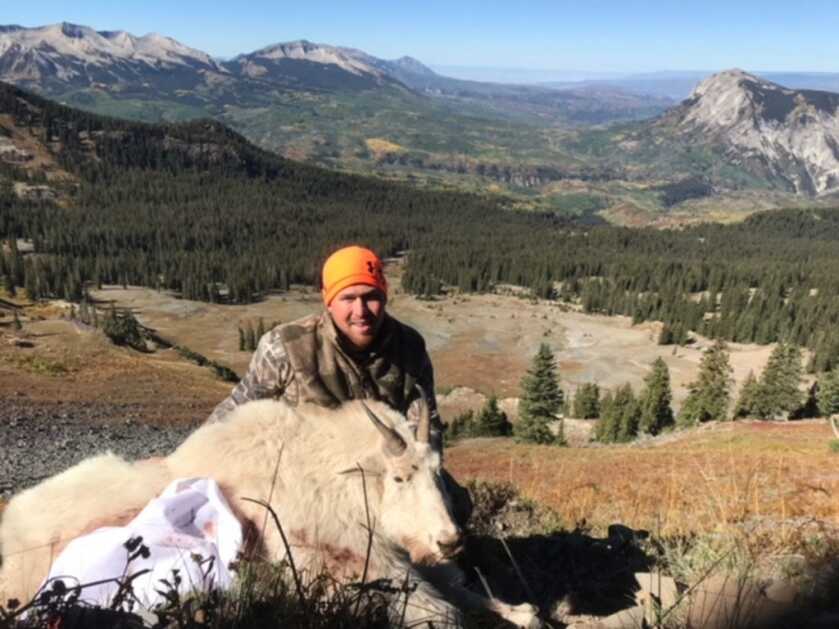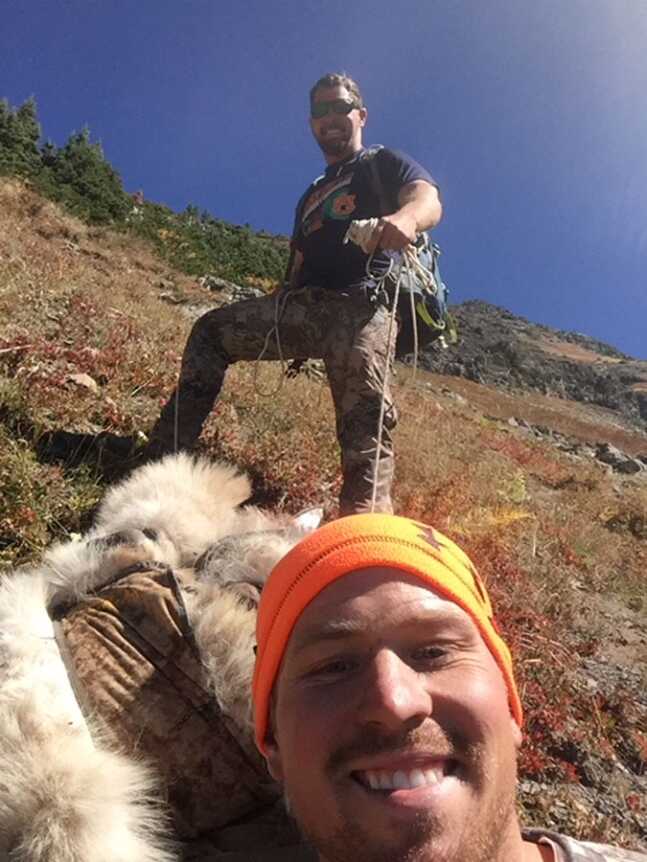Without a doubt, one of the wildest and most rugged big game animals in North America is the Rocky Mountain Goat. This incredible beast never migrates down during the sub-zero winter months, and you rarely see them below 9,000 feet. They have never tasted a kernel of corn, and I can guarantee you that no one will ever shoot one making its way to or from a hay field. This amazing creature makes its living in an alpine environment year-round and runs across rock faces like most animals run across flat ground. Having an opportunity to hunt these amazing animals is truly a mountain hunter’s hunt, and I can assure you that you will earn every inch of their 10-inch horns.
I had the rare opportunity to hunt these amazing creatures in the Colorado Rockies. I had drawn a goat tag near Crested Butte, Colorado and I could tell from the very first scouting trip that I was in for a challenging hunt. The moment I left the trailhead on my first scouting trip with my wife we faced an eight-mile hike with an average of eight percent grade. Until this first venture into the wilderness, I had never laid my eyes on a wild mountain goat. I had only ever seen them on television or in captivity, but as we crossed the threshold from aspen and spruce trees to rugged rocky peaks and high alpine bowls, that changed. I threw my Vortex Diamondback binoculars up to my eyes and spotted two white dots on the side of the steepest cliff I had ever seen. I was able to grab my spotting scope and confirm that they were indeed mature billy mountain goats. I would make this sixteen-mile round trip hike four more times over the coming months, watching and learning about the three billies that lived in the bowl I wanted to hunt.
I realized early on that I was going to need some help getting my equipment up the mountain, and more importantly, back down the mountain after the hunt. I quickly started the search for pack horses. Pack horses would also allow my father to come along on the hunt. I have always thought that it’s not the hunt itself that is special, it is who you share the hunt with that really makes memories. After some searching, I settled on Dave Mapes, with Quaking Aspen Outfitters, out of Gunnison. He would take, me, my father and my hunting partner with 6 horses up the mountain to a campsite I had picked during the summer, drop us off and return seven days later to bring us off the mountain.
After months of planning, the time was finally upon us. I was out of the country during the first week of the season, so I had to start a week later than the other hunter in my unit. With only two tags issued, I wasn’t too worried about competition on this hunt.

Pack String being loaded up at the trailhead with the peaks of the mountains we are hunting in the background.
We met at the trailhead at nine in the morning on September 12, eight days after the start of the season. The packers arrived on time and promptly loaded all of our gear onto our four-legged friends and we proceeded up the mountain. It was one of the most beautiful sights I have ever seen in Colorado. The aspens were just starting to turn and we rode through a forest of gold and ruby colored leaves. I can honestly say that this trip up the mountain was the most pleasurable one I could add to my list. The eight miles that I normally walked up and back in a day on my own two legs were being covered much faster by the four legs my horse had. We made it up to the campsite in a little under 4 hours, the packers unloaded our gear just as fast as they had loaded it and were on their way back down the mountain.
The campsite I had chosen was at 10,500 feet, just inside the treeline of the bowl I wanted to hunt. This allowed us to be protected from unpredictable weather, and left us just under a mile hike in the mornings to where we would be hunting. The three of us were excited to start hunting that evening, but we had to set up camp first. The beauty of horses was I was able to pack my Cabela’s outfitter series 12 x 12 Alaknak tent, and Kni-co stove. The tent allowed all three of us plenty of room to sleep and store gear and the stove made the frigid nights much more comfortable. Our camp also consisted of a small cook tent, where we kept an ample supply of Mountain House dehydrated food, which we prepared with a Camp Chef Stryker 100 isobutane stove, boiling a liter of water in two minutes. Throughout the hunt, it was nice to come back to a warm meal and a very dependable way to cook them.

Camp set up, complete with the Cabela’s outfitter tent and the Kni-co stove. A very comfortable way to hunt the backcountry.
Camp was set up in under an hour, and we were eager to get out and glass up some billy’s in the afternoon. We took out from camp and headed up the trail where there was a nice spot to glass. The Vortex Diamondback 20 x 60 quickly turned up a nice billy two or three miles away. Not much was said, other than pack our stuff up, we are going to get a better look. We took off trying to cover as much ground as we could, the sun was our biggest competition as it was late in the afternoon and we needed to get into position with enough light left in case we wanted to take a shot. What seemed like it was going to be an easy two-mile hike turned into a very challenging experience. That type of country is so big that you have no perception of what is flat and what is slopped. We covered the distance over the uneven grass-like tundra and had to get across two small bowls that we didn’t even know were there, all to attempt to scale a rock wall.
Making it up the rock face was very difficult. We had to take our time one after the other because we would free large rocks that would plummet 200 feet to the bottom and we didn’t want our fate to be the same.
We made it to the only flat spot for what seemed like miles, and there was the billy. He was a very nice mature goat, about 8 inches long with a great coat. He was certainly nothing to scoff at for a Colorado mountain goat. We got in position to take a shot, only to realize that there was no way that we were going to be able to get to him if we shot him. We watched the sun go down, and with that, the first day of the hunt was over.
It took us well over three hours to get back to camp that night, we couldn’t go down the way we had come up the mountain and we got cliffed out several times attempting to get back to the trail. With the fire my father lit at camp as our only guiding light we finally made it back to camp around midnight after a long and strenuous evening of cutting a new trail.
The next morning, the sun beat us up. The night before left us slow moving. The plan for the day was made around the campfire and we set off after breakfast. Moving toward the bowl we wanted to hunt, my hunting partner made his way into a clearing to glass the face and spotted a billy immediately. I laid eyes on him just as he bedded down on a ledge. Quickly I decided we needed to cut some distance toward him and we made our way to a small stand of trees about 600 yards from the goat. We again pulled out the spotting scope, this time affixed with a Carson HookUpz 2.0 smartphone adapter connected to the spotting scope. This really let us zoom in and see what kind of billy we were looking at. He presented several shot opportunities while we were deciding if the billy was worth a shot. Through the scope we could see that the billy was great for Colorado—he looked to be in the 8-inch range with good mass and a really nice coat. (The coat on a mountain goat is half the trophy.)

Pictures taken through the Carson HookUpz 2.0 smartphone adapter and Vortex Diamondback 20x60x80 spotting scope of our shy billy.
As soon as we decided to set up for a shot the billy decided to bed down just where we couldn’t get a shot. Through some small trees, we could see that he was just sunbathing on top of the ridge with no urgency to go anywhere. He stood up and bedded back down several times, still offering no shot. We had first spotted the billy at 8 am, and it was now 3pm. We had watched him all day, waiting for him to come just five feet our way so we could make a good shot and drop him in less steep country. He was not playing along with the plan. Around 3:30 the billy scurried over the ridge and out of sight. I fought the urge to climb up the mountainside, knowing that if I spooked him he could cover more ground in 5 minutes than I could in a day. We decided to wait him out, and sat under our tree covered hideout until dark, with no sign of the billy.
Walking back to camp that night we decided to go back to the exact same spot in the morning, well before light and set up, hoping that the billy would conduct the same morning routine that he had the day before.
That night was restless, wondering if the big billy would revisit the same open area as he had the day before. Finally, after what seemed like forever, it was time to get up and see what the day would give us. We set out from camp, racing the sun to the spot we had left. I went directly to the tree that I had spent hours under the day before while my hunting partner decided to stay back about 100 yards to get a different angle on the hillside. The mountain was lit by the morning light and, nothing. Time crept by like molasses. The sun crept higher and I felt that my chances of the billy reemerging where becoming fewer with every passing minute.
I picked and peeled apart the hillside with my binoculars. Then, at 7:50 I could see a white image moving through the trees. It was him. I didn’t even have to look twice. I immediately motioned for my buddy to leave his vantage point and run over to where I was getting set up. I pulled my McMillan Tac 300 out of the pack. In reality, this gun is much too heavy for a mountain hunt, being almost 25 pounds, but my scouting had allowed me to know the area well enough that I was willing to carry around this rifle for the confidence of knowing that almost no shot would be out of range.

The McMillan Tac 300 with Nightforce Beast positioned waiting for the billy to step into the shooting lane.
I made my shooting platform steady and focused the Nightforce Beast scope in on the shooting lane that I had picked out for the goat. The crispness of this glass really made the 530-yard shot feel like it was a chip shot.
As we waited for the goat to step into the perfect place, my partner called the wind and range. I dialed the turrets of the scope to the correct distance and waited for the perfect moment. The goat was surrounded by cliffs on either side and only the perfect shot would leave him in a place that we could access and that wouldn’t break his horns if he fell. He was making his way across the opening where I had planned to shoot. He didn’t look like he would stop until he reached the other side, then for a split second, he stopped in the perfect place. I gently touched off the McMillan and let the 180-grain 300 Win. mag Federal Trophy copper fly. Smoked him! With one perfect shot, I brought the billy to his knees. But that didn’t stop him from rolling 200 feet down the mountainside. This was by far the most stressful part of the hunt. I was terrified that his horns would break or that he would plummet off a cliff on his way down. Miraculously, he fell down the perfect schute and ended up on the only flat perch on the hill. We watch anxiously for a few moments to make sure he was dead. After watching him for a minute we knew he had expired and we began to celebrate. The hunt had been tough, but the pack to camp would turn out to be the real test of the hunt.
We crept up the nearly vertical slope to the billy, I laid my hands on him for the first time and realized what an amazing animal he was. You really gather an appreciation for what these animals live in when you climb into their domain. We began to cape and break him down after taking pictures. The slope was so steep that we had to tie a rope around a tree in order to keep him from falling further down the slope.
We managed to get all four quarters, backstraps, head and cape into my Cabela’s outfitter pack frame. The only issue is that the hillside was so steep that we couldn’t get the pack on my back to get off the mountain. The solution that we came up with was to belay the backpack and me down the slope a few feet at a time. This took us over an hour, just to go 200-yards. Finally, we reached an area that we could finally get the pack on our backs. Even then it was so heavy that we had to switch every 100 yards or so, progress went very slowly. It took us 5 hours to get back to the place that we had made the shot from, and we were still 2 miles from camp.
We radioed to my father who was at camp and it turned out he had made friends with some elk hunters from Minnesota who had pack horses. Being the social butterfly my father is, he convinced the pair to meet us on the trail and pack the billy and our gear the final 2 miles to camp. I have never been so happy to see a horse in my life. The duo met us on the trail and packed us triumphantly to camp.
That night we celebrated around the fire with some goat tenderloin and reminisced about the day’s adventure. Just like that my Colorado Mountain goat hunt was over. The packers came up the next day to take us off the mountain. The whole ride down I couldn’t help but think how lucky I had been to take a great billy in such a beautiful place with some special people. I had gained an appreciation for these majestic animals. I have often heard mountain hunters say that goats live in places that sheep can’t, and after this adventure I must say that I tend to agree with them.







I would love to hunt them, but could not afford the price alone be lucky to get a tag. Just have to dream about it,